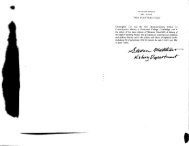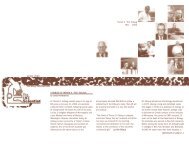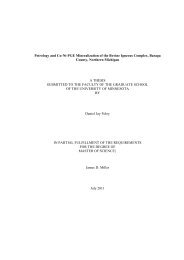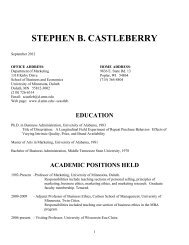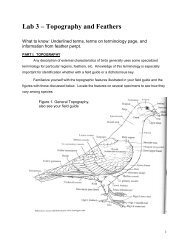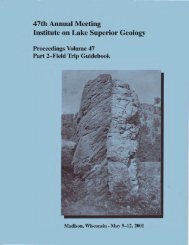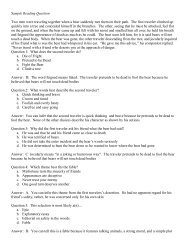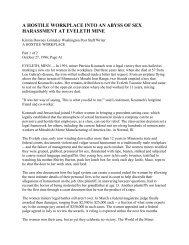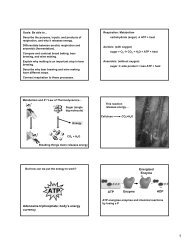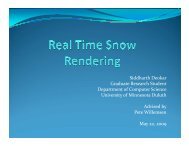Program, Abstracts, and Guidebooks - University of Minnesota Duluth
Program, Abstracts, and Guidebooks - University of Minnesota Duluth
Program, Abstracts, and Guidebooks - University of Minnesota Duluth
You also want an ePaper? Increase the reach of your titles
YUMPU automatically turns print PDFs into web optimized ePapers that Google loves.
a<br />
—56—<br />
at Disraeli Lake <strong>and</strong> near Stewart Lake belong to the group Conophyton<br />
(H<strong>of</strong>fman, 1969), formed <strong>of</strong> vuggy columnar "cone in cone" structures<br />
(Plate lb). The chert facies ranges to 10 feet in thickness at Ross—<br />
port, <strong>and</strong> is composed <strong>of</strong> finely laminated grey to black chert <strong>and</strong><br />
brown dolomite. Anthraxolite, accumulations are common along the base<br />
<strong>of</strong> this unit.<br />
The overlying limey red mudstone contains less than 20 per cent<br />
coarse microcline with less than 2 per cent hematite. The clay<br />
exp<strong>and</strong>s itt ethylene glycol, <strong>and</strong> is a mixed layer chlorite—montmor—<br />
illonite, similar to corrensite (Peterson, 1961). The feldspar is<br />
very fine—grained (less than 10 p diameter) <strong>and</strong> is probably authigenic.<br />
The overlying purple mudstone unit is finely laminated,<br />
moderately but irregularly fissile, <strong>and</strong> is composed <strong>of</strong> approximately<br />
40 per cent each <strong>of</strong> corrensite <strong>and</strong> microcline, with less than 4 per<br />
cent hematite, less than 15 per cent quartz, <strong>and</strong> minor calcite. Less<br />
than 10 per cent coarse clastic material is present in most <strong>of</strong> this<br />
unit.<br />
The uppermost limestone unit is grey to buff, poorly bedded,<br />
<strong>and</strong> crops out only north <strong>and</strong> west <strong>of</strong> Nipigon.<br />
The Sibley Group is distributed over both the edge <strong>of</strong> an older<br />
mobile belt (the Penokean orogenic deformation <strong>of</strong> Aphebian rocks)<br />
<strong>and</strong> the stable Archean craton. Deposition occurred in a basin restricted<br />
on the south <strong>and</strong> west by uplifted Aphebian rocks. A shallow,<br />
periodically dry, basin transgressed northward over the craton.<br />
Material was derived from both the Aphebian highl<strong>and</strong>s <strong>and</strong> adjacent<br />
Archean granitic rocks in a semi—arid, warm environment, (Franklin,<br />
1970).<br />
NEOHELIKIAN<br />
Osler Grçp<br />
Volcanic <strong>and</strong> sedimentary rocks <strong>of</strong> the Osler Group disconformably<br />
overlie the Sibley Group <strong>and</strong> are exposed on an arcuate belt <strong>of</strong> isl<strong>and</strong>s<br />
parallel to the shore <strong>of</strong> Lake Superior, <strong>and</strong> on Black Bay Peninsula<br />
(Ont. Dept. Mines Map 2137). The lavas are similar to those <strong>of</strong> the<br />
Portage Lake Lava Supergroup (DuBois, 1962) <strong>and</strong> are composed <strong>of</strong> thin,<br />
laterally extensive sheets <strong>of</strong> vesicular, tholeiitic flood basalt with<br />
minor interf low greywacke beds, & rhyolite (quartz porphyry) bodies.<br />
Intrusive Rocks<br />
The four types <strong>of</strong> intrusive rocks present in this area are as<br />
follows:<br />
(a) Logan sills: laterally extensive thin diabase sheets,<br />
cutting Archean, Aphebian, <strong>and</strong> Paleohelikian rocks<br />
(b) northeast—trending gabbro dykes, parallel to the<br />
shore <strong>of</strong> Lake Superior, extending from Pigeon Point to Edward Isl<strong>and</strong>




